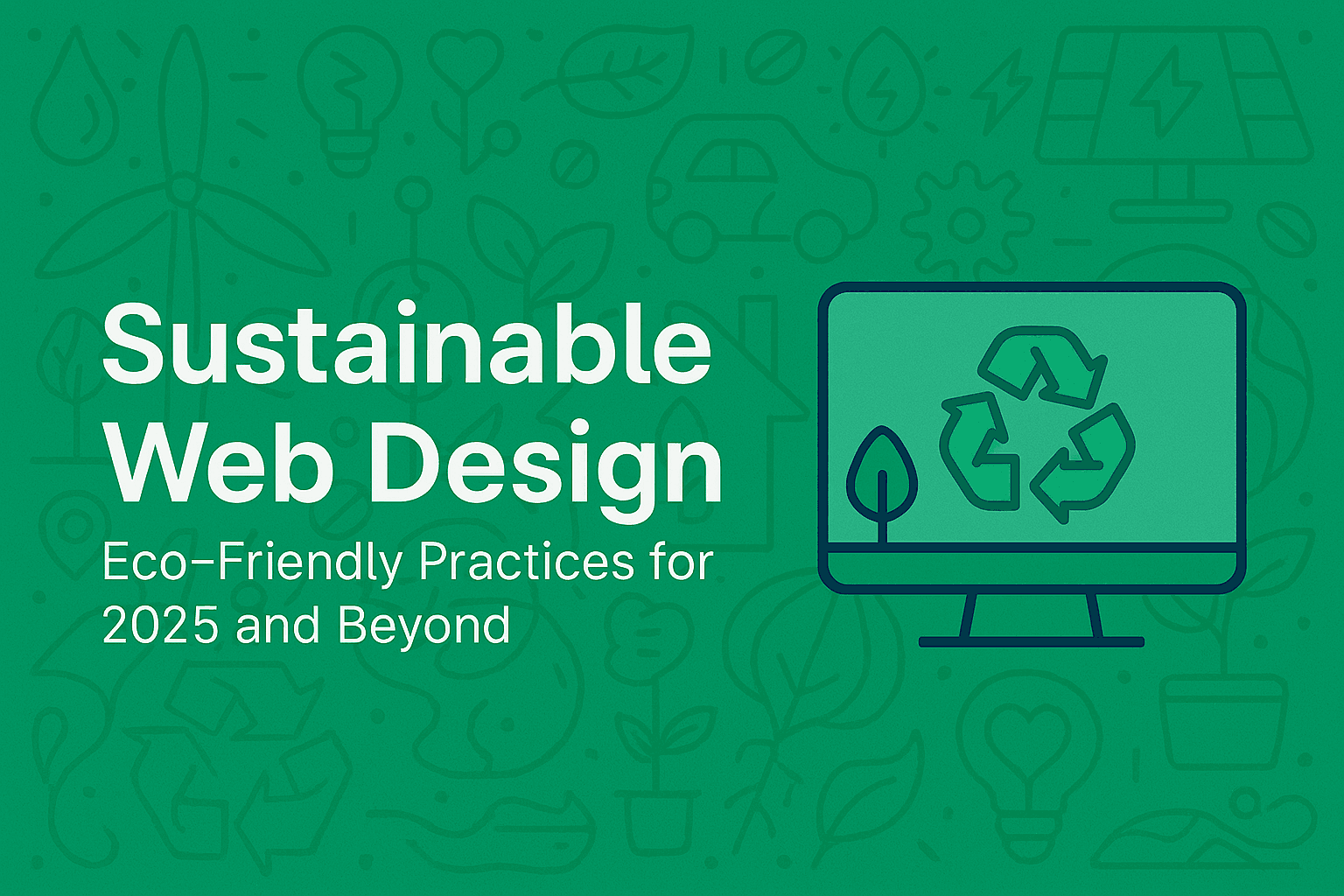Sustainable Web Design: Eco-Friendly Practices for 2025 and Beyond

As the digital world continues to expand, the environmental footprint of the internet grows exponentially. Every search, image, and website visit consumes energy — and as our online presence intensifies, so does its carbon impact. This is where Sustainable Web Design comes into play.
In 2025 and beyond, eco-friendly web design has become a critical component of digital strategy. It’s not just about aesthetics or performance anymore — it’s about building a greener internet. In this comprehensive guide, we’ll explore what sustainable web design means, why it matters, and how businesses, designers, and developers can adopt eco-friendly practices that support both performance and planet.
What Is Sustainable Web Design?
Sustainable Web Design refers to designing and developing websites that minimize environmental impact. It involves optimizing energy consumption, reducing data transfer, and ensuring the website’s lifecycle — from hosting to user interaction — is as eco-friendly as possible.
In essence, sustainable design is digital minimalism: creating websites that load faster, use fewer server resources, and deliver information efficiently without unnecessary code or content bloat.
Why Sustainable Web Design Matters in 2025
The internet contributes approximately 3.7% of global carbon emissions, a figure projected to rise sharply by 2030. As more businesses move online, the demand for data centers, cloud services, and digital infrastructure increases — all consuming enormous amounts of electricity.
Here’s why sustainable web design has become a global priority in 2025:
-
Corporate responsibility: Companies are expected to adopt eco-friendly practices across all digital operations.
-
Performance efficiency: Eco-conscious websites tend to load faster, improving UX and SEO rankings.
-
Cost savings: Optimized websites use fewer server resources, reducing hosting and operational costs.
-
Consumer demand: Users increasingly prefer brands that align with sustainability values.
Sustainable web design is no longer a trend — it’s a necessity for the next generation of the web.
Core Principles of Sustainable Web Design
To build a greener internet, designers and developers must adhere to key sustainability principles. Here are the foundational pillars of eco-friendly web design for 2025 and beyond:
1. Energy Efficiency
The biggest goal is reducing the energy required to load and interact with a website. This means optimizing images, videos, and scripts to minimize data transfer.
2. Sustainable Hosting
Using green web hosting powered by renewable energy sources like wind, solar, or hydroelectricity is one of the most impactful eco-friendly choices.
Providers such as GreenGeeks, A2 Hosting, and SiteGround now offer carbon-neutral or energy-efficient hosting solutions.
3. Minimalist Design
Minimalism in sustainable web design means removing unnecessary elements. Fewer images, lighter typography, and streamlined layouts reduce the site’s carbon footprint while improving speed and clarity.
4. Efficient Code
Writing clean, modular, and optimized code ensures faster performance. Using lightweight frameworks, avoiding redundant libraries, and lazy-loading content can significantly cut energy consumption.
5. Longevity and Scalability
Designing with longevity ensures websites remain relevant and adaptable without frequent rebuilds, reducing digital waste.
Eco-Friendly Web Development Practices
Developers play a crucial role in ensuring sustainability through efficient coding, performance optimization, and resource management. Here are actionable strategies for green web development in 2025:
1. Optimize Images and Videos
-
Compress all images using modern formats like WebP and AVIF.
-
Use responsive image techniques to serve smaller files on mobile.
-
Lazy-load media to prevent unnecessary data loading.
2. Reduce Server Requests
Combine CSS and JS files where possible, and use caching strategies to minimize repeated requests.
3. Implement Green Hosting
Migrate to hosting providers committed to renewable energy. Check certifications like Green Web Foundation Directory for verified eco-hosts.
4. Use Lightweight Frameworks
Avoid bulky frameworks and excessive dependencies. Static site generators like Gatsby or Hugo can reduce server strain.
5. Embrace Progressive Web Apps (PWAs)
PWAs store data locally, requiring fewer network requests, which helps reduce data center load and energy use.
Sustainable Web Design for UX and Performance
User experience (UX) and sustainability go hand in hand. A sustainable website is inherently more user-friendly — faster, simpler, and more accessible.
Key UX Strategies for Sustainable Web Design:
-
Simplify Navigation:
Reduce clicks and keep menus intuitive to lower page load times. -
Prioritize Readability:
Use web-safe fonts and clear contrasts to reduce rendering time and improve accessibility. -
Design for Speed:
Pages that load within 2 seconds not only improve SEO but also reduce energy consumption. -
Dark Mode Designs:
Offering dark mode reduces power consumption on OLED and AMOLED screens. -
Inclusive Design:
Accessibility features like ARIA labels and keyboard navigation support longer usability lifespans for websites, aligning with sustainable goals.
Measuring the Carbon Footprint of Your Website
To make sustainability measurable, web designers use tools that calculate the carbon emissions of websites. These tools estimate how much energy your site consumes per visit and how that translates into CO₂ output.
Top Tools for Measuring Website Carbon Emissions:
-
Website Carbon Calculator (websitecarbon.com)
-
EcoGrader
-
Beacon
These platforms analyze factors like page size, hosting efficiency, and transfer protocols to estimate environmental impact. The goal? To achieve less than 1g CO₂ per page view, a benchmark for sustainable web performance in 2025.
Best Tools for Sustainable Web Design in 2025
Here are essential tools and platforms that support sustainable, eco-friendly web development and design:
| Category | Tool | Purpose |
|---|---|---|
| Hosting | GreenGeeks, Krystal, EcoHost | Renewable-powered hosting |
| Optimization | TinyPNG, ImageOptim, Squoosh | Compress images efficiently |
| Code Efficiency | Lighthouse, GTmetrix | Audit website performance |
| Monitoring | Ecograder, Website Carbon Calculator | Measure carbon footprint |
| Static Site Builders | Hugo, Gatsby, Next.js | Lightweight, serverless builds |
These tools empower developers to balance performance, aesthetics, and environmental sustainability seamlessly.
The Role of Green Hosting in Sustainable Web Design
Web hosting accounts for a significant portion of a site’s carbon emissions. As data centers consume vast amounts of electricity, choosing an eco-friendly hosting provider becomes crucial.
Benefits of Green Hosting:
-
Uses renewable energy sources (solar, wind, hydro).
-
Offers carbon offset programs.
-
Provides energy-efficient data centers.
When selecting a hosting provider in 2025, check their energy transparency reports, certifications, and data center locations to ensure they align with your brand’s environmental commitments.
Sustainable Content Strategy: Writing for Impact and Efficiency
Sustainability extends beyond design and code — it includes how content is created and consumed.
Here’s how content creators can embrace sustainable web design principles:
-
Prioritize Quality Over Quantity:
Publish fewer, more valuable articles to reduce unnecessary data and server strain. -
Use Compressed Media:
Avoid auto-playing videos or high-resolution images unless essential. -
Optimize for Accessibility:
Use semantic HTML and alt text for images to improve usability and reduce rework. -
Focus on Readability:
Easy-to-read content lowers bounce rates and improves user satisfaction. -
Evergreen Content:
Create content that remains relevant over time, reducing update frequency and digital waste.
Sustainable Web Design and SEO: A Perfect Match
Sustainable Web Design naturally aligns with SEO best practices. A fast, optimized, and user-friendly website ranks higher on search engines — benefiting both visibility and sustainability.
SEO Benefits of Eco-Friendly Web Design:
-
Faster loading speeds = higher rankings
-
Reduced bounce rates = improved engagement metrics
-
Mobile optimization = better UX scores
-
Clean code structure = improved crawlability
Sustainability and SEO are now inseparable. Google’s Core Web Vitals directly reward eco-friendly performance optimization, making green web design a vital part of digital marketing success in 2025.
Future of Sustainable Web Design: Trends Beyond 2025
The next decade will see sustainability embedded deeply into digital ecosystems. Emerging trends shaping the future of sustainable web design include:
-
AI-Powered Optimization:
AI tools will auto-optimize websites for performance and carbon efficiency. -
Blockchain for Transparency:
Blockchain-based hosting could help verify renewable energy usage in data centers. -
Carbon-Neutral UX Design:
Future UX strategies will prioritize minimal interaction paths to reduce page loads. -
Circular Digital Design:
Reusable code components and modular designs will minimize development waste. -
Global Standards for Web Sustainability:
Expect organizations like W3C to standardize sustainability metrics for websites.
How Businesses Can Implement Sustainable Web Design in 2025
Adopting sustainable web design isn’t just a developer’s task — it’s a company-wide commitment. Here’s how businesses can get started:
-
Audit your website’s carbon footprint.
-
Choose a green hosting provider.
-
Train design and dev teams on eco-friendly practices.
-
Adopt a minimalist design philosophy.
-
Monitor, optimize, and repeat.
By 2025, sustainable web design has become a core part of corporate social responsibility (CSR) — not just a marketing buzzword.
Building a Greener Digital Future
Sustainable Web Design represents the future of digital innovation — where technology, design, and ecology unite. By adopting eco-friendly practices, businesses can reduce their digital carbon footprint while enhancing performance, user satisfaction, and brand reputation.
The web of the future isn’t just smart — it’s sustainable. And every choice, from the code you write to the hosting you select, shapes a cleaner, greener internet for generations to come.
